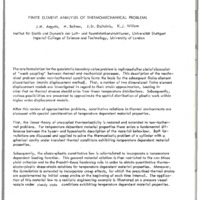Finite Element Analysis of Thermomechanical Problems
Item
- Title
- Finite Element Analysis of Thermomechanical Problems
- Description
-
The rate formulation for the quasistatic boundary value problem is rephrased after a brief discussion of "weak coupling" between thermal and mechanical processes. This description of the mechanical problem under non-isothermal conditions forms the basis for the subsequent finite element discretisation (matrix displacement method). First, a number of two dimensional finite element displacement models are investigated in regard to their strain approximation, bearing in mind that no thermal stresses should arise from linear temperature distributions. Subsequently, various possibilities are presented to approximate the spatial distribution of plastic work within higher order displacement models.
After this review of approximation problems, constitutive relations in thermal environments are discussed with special consideration of temperature dependent material properties.
First, the Iinear theory of uncoupled thermoelasticity is restated and extended to non-isothermal problems. For temperature dependent material properties there exists a fundamental difference between the hyper- and hypoelastic description of the material behaviour. Both formulations are discussed and applied to solve the thermoelastic problem of a cylinder with a spherical cavity under transient thermal conditions exhibiting temperature dependent material properties.
Subsequently, the elasto-plastic constitutive law is reformulated to incorporate a temperature dependent loading function. This general material relation is then restricted to the von Mises yield criterion and to the Prandtl-Reuss hardening rule in order to obtain quantitative thermoelasto-plastic stress-strain relations for temperature dependent material properties. Moreover, the formulation is extended to incorporate creep effects, for which the prescribed thermal strains are supplemented by initial creep strains at the beginning of each time interval. The application of this material law to a realistic engineering example is illustrated on a pressure vessel nozzle under steady state conditions exhibiting temperature dependent material properties. - Creator
- Argyris, J. H.
- Balmer, H.
- St. Doltsinis, J.
- Willam, K. J.
- Abstract
-
The rate formulation for the quasistatic boundary value problem is rephrased after a brief discussion of "weak coupling" between thermal and mechanical processes. This description of the mechanical problem under non-isothermal conditions forms the basis for the subsequent finite element discretisation (matrix displacement method). First, a number of two dimensional finite element displacement models are investigated in regard to their strain approximation, bearing in mind that no thermal stresses should arise from linear temperature distributions. Subsequently, various possibilities are presented to approximate the spatial distribution of plastic work within higher order displacement models.
After this review of approximation problems, constitutive relations in thermal environments are discussed with special consideration of temperature dependent material properties.
First, the Iinear theory of uncoupled thermoelasticity is restated and extended to non-isothermal problems. For temperature dependent material properties there exists a fundamental difference between the hyper- and hypoelastic description of the material behaviour. Both formulations are discussed and applied to solve the thermoelastic problem of a cylinder with a spherical cavity under transient thermal conditions exhibiting temperature dependent material properties.
Subsequently, the elasto-plastic constitutive law is reformulated to incorporate a temperature dependent loading function. This general material relation is then restricted to the von Mises yield criterion and to the Prandtl-Reuss hardening rule in order to obtain quantitative thermoelasto-plastic stress-strain relations for temperature dependent material properties. Moreover, the formulation is extended to incorporate creep effects, for which the prescribed thermal strains are supplemented by initial creep strains at the beginning of each time interval. The application of this material law to a realistic engineering example is illustrated on a pressure vessel nozzle under steady state conditions exhibiting temperature dependent material properties. - Corporate Author
- lnstitut fur Statik und Dynamik der Luft- und Raumfahrtkonstruktionen, Universitat Stuttgart
- Imperial College of Science and Technology, University of London
- Report Number
- AFFDL TR 71-160 p. 729-771
- Report Availability
- Full text available
- Publisher
- Wright-Patterson Air Force Base, OH : Air Force Flight Dynamics Laboratory, Air Force Systems Command and Air Force Institute of Technology, Air University
- Date
- 1973
- Type
- article
- Date Issued
- 1973-12
- Provenance
- Bombardier/Aero
- Distribution Classification
- 1
- Distribution Conflict
- No
- DTIC Record Exists
- No
- Format
- 1 online resource (42 pages) : ill.
- Extent
- 42
- Identifier
- AD0785968
Linked resources
Warning: Undefined array key "id_concat" in /var/www/html/omeka-s/themes/foundation/view/common/linked-resources.phtml on line 40
Warning: Undefined array key "property_alternate_label" in /var/www/html/omeka-s/themes/foundation/view/common/linked-resources.phtml on line 41
Warning: Undefined array key "property_label" in /var/www/html/omeka-s/themes/foundation/view/common/linked-resources.phtml on line 43
| Title | Class |
|---|---|
| Proceedings of the Third Conference on Matrix Methods in Structural Mechanics: Proceedings of the Conference held at Wright-Patterson Air Force Base, Ohio 19-21 October 1971 |
